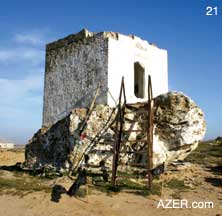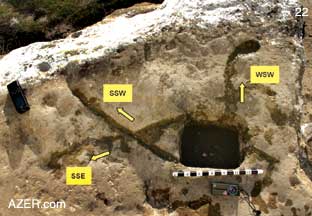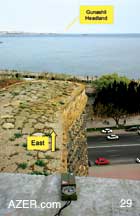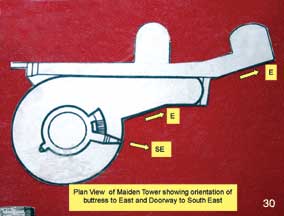|

Autumn 2006
(14.3)
Pages
40-63
Maiden Tower
Secrets
of the Maiden Tower:
What They Reveal about Early Man's Beliefs
(Scroll
for article)
by Ronnie Gallagher and Betty Blair
Photo Essay
1. Cupmarks in South Easterly Direction in Azerbaijan
2. Sacrifical
Holes in North Easterly
Direction in Azerbaijan
3. Maiden
Tower in Photos
4. Maiden
Tower Exterior
5. Maiden
Tower Interior
6. Maiden
Tower in Music
7. Mud
Volcanoes
8. Earth
Goddess Monument in Azerbaijan
Baku's most predominant landmark
- The Maiden Tower - continues to beg for more research into
its origins and function. Could there possibly be links to a
much earlier beginning for this monument than archaeologists
have yet to suggest? Could it be that the design of Maiden Tower
itself acts as an observatory and incorporates man's awareness
of celestial movements, particularly the sun? Is there a religious
intent in the design of the tower which predates the great religions
of Zoroastrianism, Judaism, Christianity and Islam? These questions
are explored here in light of similarities found that relate
to other intriguing Megalithic monuments scattered around the
countryside in Azerbaijan.
If the assumptions and deductions in this article are correct,
this would suggest that additional archaeological and astro-archaeological
research is needed. Indeed, closer examination of Maiden Tower
may turn up some very startling facts about Early Man and civilization,
which could have implications far beyond Azerbaijan.
Careful observation of the heavens, particularly the pathway
of the sun, is as old as mankind. In Azerbaijan there is evidence
that early man observed celestial movements and incorporated
them into his religious and cultural practices. This is one of
the possible conclusions that can be reached from observing the
objects made by inhabitants of the Neolithic and Early Bronze
Age some 3000-5000 years ago.
In exploring the countryside, we (Ronnie Gallagher, Abbas Islamov,
and Betty Blair) have observed many fascinating examples of ancient
handicraft - rock shelters, stone circles, burial mounds (kurgans),
chambered cairns and cart ruts - to name a few. [See Side Bar
for articles].
But in addition to these archaeological findings, a wide range
of rock carvings have been discovered that share the common feature
of being oriented towards a specific direction. While the meaning
of such carvings has yet to be determined, evidence would suggest
that they were oriented to sunrise events and the heavens.
This observation has encouraged further research into the practices
of ancient man, leading to some tentative conclusions that may
shed light on the evolution of religious traditions and belief
systems that may have been followed for thousands of years in
the region.
In comparing the rock carvings found throughout the countryside
to the architectural design of Baku's Maiden Tower (known as
"Giz Galasi" in Azeri), it has become apparent that
there are points of similarity, suggesting that the tower incorporated
elements of an early belief system. By viewing the tower through
the lens of prehistory, some of its enigmatic features begin
to make more sense and, perhaps, become more amenable to interpretation.
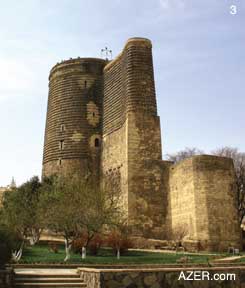  Left (3): Maiden Tower (Giz Galasi) is Baku's
most distinguished landmark. The design of this monument, both
in terms of its shape as well as the carefully situated openings
in the tower wall may point to an earlier date for construction
than archaeologists have yet suggested, possibly predating Zoroastrianism.
The authors of this article are calling for much-needed astro-archaeological
studies. Indeed, closer examination of Maiden Tower may turn
up some very startling facts about Early Man and civilization,
which could have implications far beyond Azerbaijan. Photo: GallagherIt has also become
apparent that the Maiden Tower has been modified through time
for practical purposes. For example, floors have been added on
various levels inside the Tower to facilitate tourists to better
view and ascend to the roof. Left (3): Maiden Tower (Giz Galasi) is Baku's
most distinguished landmark. The design of this monument, both
in terms of its shape as well as the carefully situated openings
in the tower wall may point to an earlier date for construction
than archaeologists have yet suggested, possibly predating Zoroastrianism.
The authors of this article are calling for much-needed astro-archaeological
studies. Indeed, closer examination of Maiden Tower may turn
up some very startling facts about Early Man and civilization,
which could have implications far beyond Azerbaijan. Photo: GallagherIt has also become
apparent that the Maiden Tower has been modified through time
for practical purposes. For example, floors have been added on
various levels inside the Tower to facilitate tourists to better
view and ascend to the roof.
The original tower seems to have simply been a hollow structure,
possibly even without a roof.
By mentally removing the floors and viewing Maiden Tower literally
and figuratively in a different light, it becomes evident that
it is a remarkable construction and technological feat, reflecting
the importance of the sun, sunlight, and water and, thus, connecting
it to ancient beliefs and traditions.
Close inspection also reveals that the Tower has also been built
upon the foundation of a more ancient structure.
This suggests that the Tower developed out of pre-existing cultural
practices, incorporating ancient design features and that it
was constructed primarily for religious purposes.
While the information presented is tenuous and difficult to prove,
it is valuable to introduce these ideas to readers, scholars
and the scientific community for further consideration. In doing
this, we hope this article will serve as a catalyst for further
study and debate.
Clearly, much work still needs
to be done to understand links between the ancient rock carvings
and Maiden Tower. For now, this review looks at the carvings
in relation to the Tower, and explores other relevant historical
information. If this presentation serves as an impetus for further
research and archaeological study, then we will consider it to
be a success.
Rock Carvings
Ancient man was well aware of the movement of celestial bodies
in the heavens. This is reflected in the orientation and construction
of ancient monuments, such as stone circles and burial mounds
or "kurgans", where cardinal point alignment has been
observed. For pastoralists and early agriculturalists, the movement
of the sun as it rises throughout the year on its annual journey
along the horizon was essential, for it brought with it seasonal
changes that directly influenced sustenance of life.
For example, the Summer Solstice (June 21st) marks the most northerly
point of the sun's journey, giving us the longest day, while
mid point to the east represents both Spring (March 21st) and
Autumnal (September 21st) Equinoxes - where days and nights are
of equal length. The Winter Solstice (December 21st) highlights
the shortest day - the lowest point of the sun in the sky in
the northern hemisphere and heralds the onset of a new annual
cycle, marked by its sunrise appearing in the southeast.
Early Man also carefully observed both nighttime and sunset for
burial reasons with bodies facing to the west - the direction
associated with the "hereafter".
It is against this background that a range of rock carvings in
Azerbaijan has been discovered - some, perhaps, new to science
- that reflect the importance of the solar cycle. While little
can be said at this time about the meaning of these carvings,
some comments can be made where functional intent is considered
plausible. For convenience, the various types of carvings are
named according to their features.
Multi-Hole Arrays
Three examples are shown of a 12-hole circular pattern, discovered
in two places near the villages of Yeni Turkan (Photos 1 and
2) on the Absheron Peninsula near Baku, and close to the Kanizdagh
Mud Volcano (Photo 5) just north of Gobustan. Each array consists
of 10 peach-sized indentations or "Cup Marks" in an
outer ring and two central cup marks, which seem to have been
used for some sort of counting function. In each example, a line
may be drawn through the two inner Cup Marks to connect to the
outer cups. In both cases, that line indicates a northwest to
southeast (NW/SE) orientation.
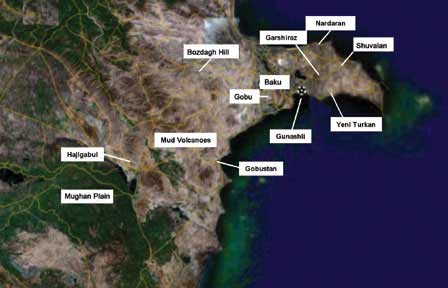
Above: Map shows site locations of archaeological
interest that are mentioned in this article. Photo: Google Map
Another array (Photo 6) was discovered on a limestone outcrop
near the village of Nardaran on the Absheron Peninsula. This
has 10 Cup Marks arranged in two rows of four, with two holes
on either side. Curiously, it also reflects a NW/SE alignment.
Photo 7 from a "Stone Circle" at Shuvalan shows a complex
array of small indentations and interconnecting channels. This
array bears a marked resemblance to the ancient Near East board
game known as "Hounds and Jackals"1examples of which have been found as
"grave goods" in ancient Egypt, Iraq and Palestine.
Another example located at Hajigabul (Photo 8) is also of interest
for it is associated with a much larger Cup Mark or "Pot
Hole", sometimes referred to as "ballauns". Such
ballauns may be found in megalithic sites across Europe and the
Near East. Their use is largely unknown but they are thought
to have held "holy water" and to have been associated
with religious rituals. Some ballauns, for instance, have been
adopted by early Christian missionaries and used as baptismal
fonts. Both the Shuvalan and Hajigabul carvings have a NW/SE
orientation.
The circular array shown in Photo 9 is located at a Neolithic
settlement site near the village of Gobu, just south of Baku,
on top of a rock shelter or cave. This Cup Mark array consists
of 18 peripheral Cup Marks and 4 internal ones and may have served
as a sort of calendar.
Next to this array lies a larger Pot Hole (Photo 9), which, if
viewed from the center, orients the complex to the southeast.
These all are situated within a fine example of water collection
channels and a cistern system. The cistern has a platform inside
giving easy access to water and is large enough for an adult
to sit in or even to bathe.
Then, as now, water was obviously very important for survival,
and many examples of ancient ingenuity used for collecting rainwater
have been found. But just as water is vital for life and hygiene,
the Gobu cistern and petroglyph arrays appear closely connected.
Together they may have provided a ritual or ceremonial function.
Southeast Alignment
The main point to note about multi-hole arrays is that many of
them display a consistent northwest to southeast alignment -
something that is unlikely to have happened by mere chance. As
such, there must have been an underlying reason for this. Presumably,
the intended direction was not to the northwest, but more significantly,
to the southeast - the direction of the sunrise at Winter Solstice.
V-Shaped Carvings
However, the direction of the carvings is not always to the southeast.
There is a different type of carving that for convenience may
be called a "V-shaped Sacrificial Hole". The "V"
here represents two limbs that orient to the east and northeast
(Photos 10 and 11). Each object has a hollowed out cavity at
the apex of the "V". Several of these carvings were
found on the Absheron Peninsula near the village of Yeni Turkan
though, sadly, they no longer exist as they were destroyed in
2003 by blasting caused by a nearby limestone quarry.
At first, it was thought these carvings might just be examples
of erosion, but it became apparent after some 14 examples were
discovered in a localized area, the size of a soccer field, that
they, indeed, had been manmade. Perhaps, they were simple storage
containers used to keep food or water cool from the sun. If so,
then it might be expected that we would have found other similar
carvings elsewhere, but so far we haven't.
Another possibility, in keeping with an explanation about the
worship of nature is that these carvings were constructed at
a communal "holy site", where offerings of food were
placed in the cavities to honor the "Earth Goddess"
perhaps at springtime and summer harvest. Alignment of the "V"-shaped
channels to the east (Spring or Autumn Equinox) and northeast
(Summer Solstice) is relevant and makes sense if the limbs acted
as pointers, serving as a simple calendar with respect to the
sunrise and, thus, heralding the time for ritual ceremonies.
Earth Goddess
The concept of Earth Goddess was very powerful and quite widespread
in early societies. There is much evidence in archaeology at
Neolithic monuments that the Earth Goddess was worshipped. Consider
the 5,000-year-old long barrow burial mounds of Norn's Trump
and West Kennet in England, the passage grave at Newgrange, or
the megalithic sun-worshipping temples of Malta. These burial
mounds and temples are often thought to resemble the female form
(often pregnant) in honor of Earth Goddess (Photo 37).
Early men and women projected their inner thoughts and feelings
into an outer animistic world - a world where everything was
alive and spiritual. Through prayers, sacrifices and gifts to
the spirits, people believed they gained control of the phenomena
of their world. This is the commonly accepted anthropomorphic
worldview of the living earth, water, wind and fire in which
the earth was revered as the embodiment of the great goddess,
and death was perceived as a return to the womb.
Channeled Holes
Channeled Holes have been found at many ancient megalithic settlements
and are thought to be primarily associated with religious ceremonies
and the ritual sacrifice of animals. While these holes are found
in a variety of shapes and sizes and likely have other functions
as well, they do share common attributes. The central hole or
bowl may either be round or square, characteristically having
one, two or even three small channels leading into it.
Initially, it was assumed that these channels were used to collect
blood which, when spilled, was directed into the bowl. The channels
are typically about 50 cm in length, which makes them inefficient
for collecting water for utilitarian purposes. However, while
some may have been used for sacrificial purposes or for collecting
blood, others may have been used to collect rainwater, which
may have been considered "holy water" for ritual purposes.
While we might expect the orientation of the channels to vary,
if they were merely simple carvings, this is not the case. The
angle at which the channels enter or leave the hole again seems
to be relevant to the position of the sunrise at different times
of the year or to the north cardinal point.
For example, Photos 12, 13, 14 and 15 show sacrificial holes
from different areas including sites at Bozdagh Hill, Hajigabul,
Nardaran and Kanizdagh [See map: photo 4]. While channels may
either be curved or straight, each of them points in a northeasterly
direction, suggesting the direction of the Summer Solstice. Perhaps
the slightly curved channel in some samples is a refinement representing
how the sun arcs across the sky.
Photo 19 is from the Hajigabul area and illustrates a straight
channel, which points to the east - the direction of the equinoxes.
This consistency would seem to indicate that the carvings are,
once again, deliberately oriented and were used to identify specific
times of the year. Consequently, it is reasonable to assume that
they may have served as a simple calendar, such that when aligned
with the sunrise at solstice or equinox, they would signal the
time for community ritual or celebration.
Precession
However, while the channels may, indeed, point to specific directions
and may have been carved in relation to either solar and/or star
alignments, some caution is needed in their interpretation, due
to a phenomenon called "precession" referring to the
slight changes in the earth's axis of rotation that have occurred
over thousands of years. Precession is the result of the celestial
pole describing a circle - a counter - clockwise path across
the heavens over a 26,000-year period.
In addition, while the photographs shown here include a compass,
which points to the earth's Magnetic North2 and
not True North3 these
points, too, fluctuate over time. These factors make the interpretation
of the orientation of the carvings a complex study and one, which
archaeo-astronomers may further wish to explore.
Photo 21:
Hermit's House at Garshiraz
with elevated Triple-Channeled Hole (Photo 22).
Photo 22:
Garshiraz Triple-Channeled
Hole. SSE, SSW, WSW orientations. Photos: Gallagher
Consequently, carvings are locked in time, according to the
orientation that was observed by early man. For example, today
the star Polaris is closest to the North Pole, but some 5,000
years ago, the ancient Egyptians recognized Thuban in the constellation
of Draco as their Pole Star4 .The
Great Pyramid of Cheops in Egypt was originally aligned to Thuban.
Consequently, because of the antiquity of these carvings in Azerbaijan,
all of them will be slightly displaced clockwise to an extent
relative to their age. Orientation is evidently an important
aspect in these carvings and needs to be further investigated.
Indeed, knowing the intended direction may even help in determining
the age of the carvings.
Carved holes with two or more channels often have additional
features of interest. Photo 20 shows a twin-channel sacrificial
hole found next to a burial mound at Yeni Turkan on the Absheron
Peninsula. Its channels point to the northeast and east. This
carving highlights a common feature of twin-channel holes in
that the left-hand channel often has a small bend in it, near
its end. The reason for the feature is unknown, but it may have
important symbolic meaning and is discussed below in connection
with Maiden Tower.
The twin Channeled Holes from the Gobustan Heritage Center (Photo
17) and from Bozdagh (Photo 18) show consistent wider separation
in the channels pointing to the north and southeast. Possibly
these channels indicate the positions of the North cardinal point
and the Winter Solstice. Photo 16 also shows a larger twin-channeled
hole overlooking a Megalithic Stone Circle site. While its function
may have been to collect and contain water and/or the blood of
sacrificed animals, this particular example highlights another
common feature of these carvings, in that they are often elevated
and evidently visible to onlookers. It thus may be inferred that
these carvings have had a ceremonial function.
An unusual triple Channeled Hole, known locally as Garshiraz
(Photos 21 and 22) was found at a small building not far from
Baku's Heydar Aliyev International Airport. (This site is of
interest because local lore suggests that it had been an ancient
religious site or shrine where a hermit once lived. To this day,
it is regarded as a holy place where Shiite pilgrims enter to
pray and light candles.)
The nearby cup-marked rock carvings identify the location as
an ancient settlement. Again we may note here that the Channeled
Hole is elevated, but it is square shaped, not round, has two
crossing channels and has only one southeast (Winter Solstice)
channel to indicate sunrise. Two other channels point in southwest
and westerly directions towards winter and equinoxial sunsets,
which like the orientation of bodies (lying in fetal positions)
in ancient graves (kurgans) may reflect a belief in the afterlife.
The Staircase
Perhaps the most fascinating Channeled Hole (Photo 24) is the
one found at Gobustan, an archaeological site southwest of Baku
famous for its petroglyphs. Here are the two typical channels
but an additional feature appears - a staircase, somewhat reminiscent
in size to a child's dollhouse. There is a miniature set of 10
carved steps leading down to what appears to be a small platform,
which presumably was at the water level.
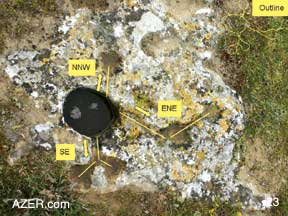 |
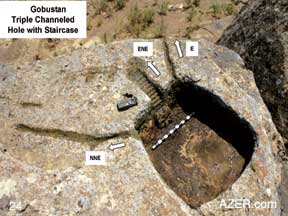 |
Left: Turkan Triple-Channeled Hole with Cup
Marks on channels.
Right: Gobustan Triple-Channeled Hole with
staircase, the size of which is reminiscent of a child's doll
house. There are 10 carved steps leading down to what appears
to be a small platform, which presumably was at the water level.
This carving is an unrecognized jewel in the Gobustan Heritage
Center. It's meaning is yet unknown. Photos: Gallagher
This carving, which is clearly an unrecognized jewel in the Gobustan
Heritage Center, does not seem to have been used for animal sacrifice.
While many interpretations may be assigned to it, rainwater surely
has to feature, as does the orientation of the channels and the
staircase. This would suggest that both immersion into the water
or exiting the water held symbolic or religious significance.
As such, it is not hard to imagine that an entity, perhaps a
spirit or god was associated with the cistern and may thus have
been related to both the sun and water.
So far in this account, the sun and water have both played important
roles. Symbolically for the ancients, both sun and fire were
similar in that they both provide heat and light to sustain life.
As such, there may be a connection to Agni5 who was recognized as the God of Fire
in three religions - Hinduism, Zoroastrianism and Indo-Tibetan
Buddhism.6
The Rig-Veda7 mentions
that he arises from water or dwells in the waters. In pre-Islamic
times, Zoroastrianism prevailed in Azerbaijan. Also a God of
Fire was identified. Not surprisingly the word "Azerbaijan"
has meant "Land of Fires" from time immemorial. Even
today in places such as Yanardagh on the Absheron Peninsula,
one can see flames issuing from the clefts in rocks on the hillside.
And in the past there have been reports where natural gas was
observed bubbling up from submerged mud volcanoes only to catch
fire on the surface of the sea.
It's no wonder that such dramatic revelations of nature are surrounded
in mystery. Coupled with other phenomena such as earthquakes
and mud volcano eruptions, such as was noted in October 2001
at Lokbatan 8 it's
not difficult to imagine that the idea of a Fire God would have
developed in Azerbaijan from very early times, perhaps even dating
back to the Neolithic period.
It's also likely that this belief was associated with water -
a most unlikely pairing only for those unfamiliar with this phenomenon.
Interestingly, Gobustan is located close to the two highest mud
volcanoes in Azerbaijan, Turaghay and Kanizdagh (Photo 21B).
Both are likely to have been sources of dramatic fire-related
events, thus making the World Heritage Site potentially more
significant than the Gobustan famous carvings alone would suggest.
Channeled holes are clearly complex and important cultural features
that seem to have religious meaning, involving the sun, water
and possibly fire.
The last example of a Channeled Hole was found at Yeni Turkan
(Photo 23). Here the channels show three key directions and orient
towards north and east (the equinoxes) as well as southeast (Winter
Solstice). In addition, unlike the simpler Channeled Holes, each
channel is more complex due to the presence of Cup Marks. While
the meaning of the Cup Marks is still unknown, they indicate
further sophistication and provide a further possible link to
the Maiden Tower.
While it cannot be said how the ancient people of this region
actually worshipped, it is apparent that their culture was rich,
consistent and evidently quite spiritual. The worship of the
sun and rain, in conjunction with a belief in the Earth Goddess
played important roles and indicate a belief system, which seemingly
lasted for several millennia, possibly from Neolithic times into
the early Bronze Age. Evidence would suggest that these age-old
practices and traditions simply did not die out, but rather gradually
became modified, merging with elements that were introduced as
new belief systems evolved. Perhaps, these beliefs even became
incorporated into the design of Maiden Tower.
Maiden Tower
An obvious point of similarity between Maiden Tower and these
Cup Marks and Channels is that the circular shape of the Tower
with its curious architectural projection or buttress resembles
a single Channeled Hole, which orients to the East. In such a
comparison, the round hole is represented by the Tower, while
the Channel represents the buttress. It is as if the "sacred
shape" has been transformed into an impressive three-dimensional
structure.
From the top of the tower, the buttress points almost due East
across the bay towards the headland of Gunashli at the tip end
of Absheron Peninsula extending out into Baku Bay. Interestingly,
the word "Gunashli" in Azeri means "sunny".
This same angle is also reflected in the lower structures of
the monument, which are older, as is seen in the plan diagram
(Photos 29 and 30).
Orientation to the East and, in particular, to the Spring Equinox
is of major religious significance. It is an event marked by
festivities world-wide by many creeds, particularly those of
the Near East. The celebration of Novruz (the Persian word for
"New Day", meaning New Year starting on the First Day
of Spring - March 21st) is recorded in documents that date back
to Arsacid / Parthian times (247 BC to 224 AD).
In Azerbaijan, Novruz is the most popular annual festival and
consists of a two-day public holiday during which plates of "samani"9 (wheat or lentil sprouts) are displayed at homes
and offered as gifts. In Iran, the public holiday extends for
two weeks. The green sprouts signify rebirth and renewal. This
tradition may explain why Maiden Tower faces east rather than
in any other direction or towards the sunrise of either of the
solstices.
However, a secondary angle is also represented in the Tower and
involves both the numerous windows and the mysterious doorway,
which orient to the southeast - the direction of the Winter Solstice
[see Front Cover], which shows a view of the sunrise at Winter
Solstice (December 21) from the odd doorway that exits to nowhere,
halfway up the tower and, thereby, emphasizes the importance
of this direction in the construction of the tower.
Maiden Tower sits on top of a rock outcrop that most likely featured
an ancient channeled hole. The site would have been an ideal
ceremonial platform - one that was used down through the ages.
To have built a tower on such a foundation is not an unreasonable
assumption as history is replete with examples where present-day
holy sites were built upon foundations deemed sacred in earlier
times.
Another clue is the slight crook or bend, which is often found
in the left-side channel of twin-channeled holes. Curiously,
this feature mirrors the odd angle in the wall of Maiden Tower's
buttress. While the feature may be co-incidental, several examples
or carvings indicate consistency and suggest the possibility
of a symbolic connection between the many carved rock samples
found throughout the countryside and the bent buttress of the
tower.
If one compares the fascinating triple-channeled hole found at
Yeni Turkan to the plan layout of Maiden Tower, other intriguing
similarities become evident. For example, in Photo 30, we can
see that the longer and, perhaps, more significant channel, pointing
eastward, resembles the east-pointing buttress wall and its low
level substructures. Here there is a remarkable similarity in
both shape and orientation. In addition, the two Cup Marks on
the carved channel are in the identical location to represent
the two curious bulbous projections or platforms of the lower
wall of Maiden Tower. This is an intriguing coincidence.
Sacrificial Stone
One final observation hints at a possible connection. Just below
the northern wall of Maiden Tower is a stone block (Photo 36).
This object has similar attributes to channeled carvings and
seems likely to have been used in sacrifices. This is evident
from its shape and the presence of a drainage channel. In this
case, the channel appears to have been designed to drain blood
away from the shallow pan-like collecting area.
Two holes that have been cut entirely through the block are located
on either side of the "pan". It would appear that these
might have been designed to somehow secure the legs or arms of
a sacrificial victim in a ritual position prior to the slaughter.
This effectively makes the object a potential killing stone or
sacrificial altar.
In summary, several points of similarity between the rock carvings
and Maiden Tower may be observed. So many similarities are unlikely
to all be co-incidental and suggest possible links between the
design of the Tower and the rock carvings. If correct, this implies
the Tower is steeped in ancient tradition, dating back to prehistoric
times to a culture that embraced the worship of the sun and nature.
The potential importance of these connections is so profound
that it prompted a closer look at the Tower's design, the legends
surrounding it, and the historical events of the two to three
millennia in which Maiden Tower has stood as a silent witness.
Maiden Tower Facelift
Today, anyone studying Maiden Tower will observe that it was
constructed on a rocky outcrop. It also appears to have been
built in two sections: an ornate top half, and a simpler, smoother
bottom section (Photos 42, 43). There have been many facelifts
over the years, and the Tower is now a mixture of ancient and
newer block work.
The description inside the tower reads as follows: "The
Maiden Tower is situated in the southeast part of 'Ichari Shahar'
[Baku's 'Old City']. This unique monument of Azerbaijani architecture
was built in two periods. Most Azerbaijani scientists suppose
the lower part of the monument up to 13.7m to be dated to the
VIIVI centuries BC.
Photo 29: Maiden Tower buttress. Angled wall
has orientation to ESE (East southeast). Photo: Gallagher
Photo 30: Plan View of Maiden Tower showing orientation
of the buttress to the East and the mysterious doorway that opens
to the SE.
"The height of the tower is 29.5 meters; its diameter is
16.5 meters. The thickness of the circular wall is five meters
at the base and four meters at the top. The Tower is an eight-storied,
cylindrical-shaped structure built upon coastal bedrock.
"Each of the eight floors is crowned with a stone cupola
with round hole. The floors are connected via a stone staircase
built within the walls themselves. Daylight penetrates the tower
through narrow window-like loop holes which are wider on the
inside. On the first floor there are some niches in the thick
walls inside, which is a pottery pipe of 30 cm internal diameter.
"There is the well of 13.5 cm diameter on the second floor
inside the tower. On the southwest section of the Tower, written
in the post Islamic Kufi script10 which is generally interpreted: "The
Tower of Masud, son of David"11 [Photos 44, 45]
"According to the kind of stone and its position, scientists
supposed these inscriptions to be rebuilt into the walls of the
Maiden Tower around the XII century during reconstruction work.
In 1960, restoration work was carried out. The unusual form and
originality of the Tower are always of great interest for Azerbaijani
scientists."
Legends
Numerous legends are associated with Maiden Tower [For Ballet
interpretations of this legend, see Photos 38-41]. One involves
the tragic story of a maiden casting herself down off the pinnacle
to her death to avoid an incestuous relationship with the city's
ruler, often identified as her father.
An alternative version of the story accuses Khunsur, legendary
founder of Baku, of locking his innocent sister in the tower.
She threw herself to her death in retaliation. As a result, God
drowned Khunsur's great pastures and created the Caspian Sea.
Other stories relate to the impregnability of such towers, hence
the name "maiden". But myths and legends should not
be dismissed outright as they often do hint at some of the original
meaning. Many of these stories involve the elements of kidnapping
a young woman and her subsequent death. While there may well
be a sacrificial component involving a highly prized victim,
such as a virgin or "first born", as is often mentioned
in ancient texts, perhaps there is a more plausible explanation
connecting the idea of a maiden with the Tower.
Stories of captured maidens are remarkably similar in ancient
myths and allegorical tales and often symbolize the cyclical
nature of renewal. The best known of these myths relates how
Hades, the god of the underworld, carried off Persephone, causing
her mother Demeter, the Goddess of Agriculture, to allow the
earth to become barren as an expression of her own grief. Zeus
then allowed Persephone to spend four months of the year in the
house of Hades and eight months in the light of day. In the Hymn
to Demeter, the earliest source of this myth, it states explicitly
that Persephone returns when the spring flowers are blossoming.
Perhaps, there is ample justification here to see a relationship
in the Tower's structure and the idea of seasonal renewal since
Maiden Tower does face towards the east-the location of the Spring
Equinox.
Indeed, there are indications that the Tower was constructed
to carry out solar observation. Historian Gara Ahmadov [spelled
Akhmedov via Russian] claims that the Tower is an observatory.
However, while it may have been constructed to view the sun and
heavens in a general sense, it is unlikely that it was built
as an astronomical observatory such as at the one in Samarkand
built by Ulugh Bey in the 15th century or the observatory in
Maragha (now Iran) during Tusi's scientific observations of the
13th century12.
The allegorical tale of a solar cycle and seasonal renewal seems
to fit neatly into the model of the Tower being a solar observatory,
a function of which was to herald the onset of spring and the
celebration of the spring festival of Novruz.
Tower Foundations
In terms of age, scientists
consider the lower section of Maiden Tower to be some 2,600 years
old. This may be partly true, not so much in relationship to
the first 13m of the tower, but rather in reference to its foundations.
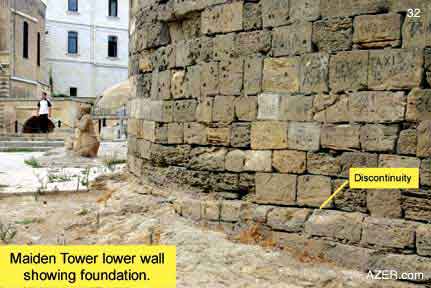
Above: Maiden Tower lower wall showing that
foundation was built upon earlier blockwork. Scientists consider
the lower section of Maiden Tower to be some 2,600 years old.
This may be partly true, not so much in relationship to the first
13m of the tower, but rather in reference to its foundations.
An older age may even be possible. They may date back to Neolithic
or Early Bronze age. Further study is needed to investigate the
age.
Indeed, an older age may even be possible. A careful examination
of the Tower reveals that it sits on top of an older more ancient
structure - possibly an ancient "sun temple". Photos
32 and 33 highlight the joint between the main tower and its
older foundations, indicating that weathering and erosion have
taken place and that the foundation is extremely old.
As implied above, the origins of the Tower at this holy site
may date back to the Neolithic or, perhaps, Early Bronze Age.
If so, then it may push the construction of the earlier foundation
upon which Maiden Tower is built back to around three or four
thousand years old. This would have to be proven scientifically;
but as incredible as it may seem, it may actually be the case.
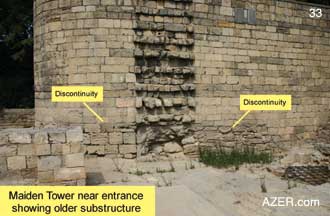
Above: Maiden Tower near entrance on North
side. Section indicates that the monument was built upon an older
structure.
Stone cuttings
In addition to the differential weathering patterns observable
on the foundation when compared to the Tower, there are also
tell-tale signs of metal tools, of saw and chisel marks on the
upper blocks, which are absent in the stonework of the foundation,
suggesting that the upper Tower was built in a different technological
age.
Indeed, the stone cutting techniques would suggest that the entire
upper Tower was built at one single occasion and not in two phases
as described in the translated description posted inside the
Tower's entrance.
Possibly, the foundation of Maiden Tower was part of an earlier
structure that developed out of the Neolithic / Early Bronze
Age traditions and which preserved the cultural designs enshrined
in the rock carvings. The present Tower itself was then built
upon this structure following the pre-existing ground plan. Clearly,
the foundation of the Tower needs to be investigated to determine
its age. If, indeed, it was designed as a "sun temple",
there are historical indications that it may have been destroyed
in the 7th century as discussed below.
The name "Baku"
Indirect evidence of the extreme age of the foundation structure
also comes from reflecting on the name "Baku". While
debates still continue regarding the origin of this word, there
are some interesting insights that may be relevant to our discussion
about the Tower itself. For example, the English archaeologist
Sir William Flinders Petrie noted that the word "Bakhay"
is used in the Egyptian "Book of the Dead" which dates
back to the 2nd millennium BC. There the word is thought to refer
to the location where the city of Baku stands today and has been
interpreted to mean "the mountain of Bakhou of the rising
Sun".
Azerbaijani Professor Sara Ashurbeyli, a leading specialist in
etymology also thinks the word dates back to Zoroastrianism,
and is derived from the word "baga" which means "Sun"
and "God" in a number of ancient languages.
Some scholars also consider Baku as an ethnotoponym - that is,
a name derived from the names of the ancient tribes "Bakan"
or "Bagi", people who inhabited the Absheron Peninsula
in the XII-V centuries BC.
The fact that Baku is referenced in an ancient text in the context
of solar worshipping is of considerable interest and suggests
that something akin to a sun temple was in existence several
millennia ago. Indeed, there may even be indirect evidence for
this, given the multiple clues of past sun and fire worship in
Azerbaijan.
Religious Regional
Heritage
Historians tell us that ancient Azerbaijan was settled by the
Medes prior to the 8th century BC. As a religion, Zoroastrianism
prevailed for nearly a thousand years throughout Azerbaijan.
Of particular importance is the fact that they worshipped at
fire temples. Perhaps the most famous Zoroastrian fire temple
is Azargashasb Shiz at the historic fortress of Takht-e Suleiman
(Throne of Solomon) near Urumia, which is presently located in
northwest Iran, which was formerly part of Azerbaijan.
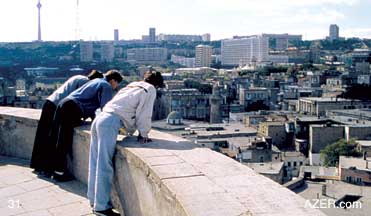
Above:
View from top of Maiden
Tower. Mid 1990s. Photo: Blair
Further information comes from
Strabo, the ancient Roman geographer, who nearly 2000 years ago
refers to the Albanians (who lived in the territory now known
as Azerbaijan) in his book Geography. He says: "As for gods,
they honor Helius (the sun), Zeus and Selene (the moon)13".
Interestingly, Strabo also refers to temples and religious practices
involving sacrifices, some of which involved humans.
Furthermore "Azar/Azer" in Persian means "fire",
"Atar" in Avestan reflects the concept of "burning
and unburning fire" and "visible and invisible fire"14. In Sanskrit
"Azer" is "Atharva", referring to the fire-worshipping
priests of the Vedic period (1500500 BCE).
With so many connections to the sun, fire, sacrifice and temples,
it is possible that the foundation upon which Maiden Tower stands
was either an ancient sun temple or possibly fire temple.
This then begs the question: "What happened to the original
temple?" "Was it destroyed?" "If so, how
did it come to be rebuilt?" While it is impossible to say
what actually happened, and what it may have originally looked
like, history again suggests a possible explanation for the destruction
of the original building whose foundation is the base of today's
Maiden Tower.
Here Edward Gibbon (1737-1794) provides some useful information
in his book, "The Decline and Fall of The Roman Empire"
(1776). Gibbon comments on the Byzantine or Roman Emperor Heraclius
(610-641 AD) and his campaign against the Persian King Chosroes
[Khosrow] II. The historian states that Heraclius over wintered
and "retreated into the province of Albania (Azerbaijan),
along the shores of the Caspian; and his tents were most probably
pitched in the plains of Mogan" [Note: Mugan is just south
of Baku]. In the course of this successful campaign, he epitomized
the zeal and revenge of a Christian emperor. At his command,
his soldiers extinguished the fire and destroyed the temples
of the Magi".
History records that Heraclius destroyed the Fire Temple at Takht-e
Suleiman in 624 AD and plundered its treasures. Given that his
army camped so close to Baku over many months, is it not plausible
that he also destroyed the structure that later provided the
foundation for building of what is now known as Maiden Tower?
If so, it suggests that an original sun temple did exist, and
may have been constructed 2,600 years ago or, perhaps, even earlier.
If this interpretation is correct, it also suggests a possible
7th century AD or later date for the re-construction of the Maiden
Tower. It further indicates that the reconstructed Maiden Tower
was an "Atash Kadeh", that is, a Parsee Fire Temple.
Evidence for the tower being an Atash Kadeh is also plausible
based on an inspection by the distinguished Parsee scholar and
traveler Dr. J.J. Modi who visited Azerbaijan in 1925. He specifically
came to Baku to study both the Fire Temple of Atashgah at Surakhani
as well as Maiden Tower in Baku.
His fascinating account is best read in the on-line reference
given in the bibliography15. As an expert in religious matters,
he identified Atashgah at Surakhani as a Hindu Fire Temple, observing
that its design, which includes a cremation pit, is different
from a traditional Parsee Fire Temple. While fire features in
both religions, cremation is anathema to Parsees.
In discussing the Maiden Tower, Dr. Modi states: "According
to my examination. . . This is an Atash Kadeh. It is not a common
Atash Kadeh with its fire maintained by burning wood by its priests,
but it is an Atash Kadeh fed by natural gas-Naphtha (apam napat).
'Haft' or seven is a very holy number in Zoroastrian religion
and, hence, there are seven storeys or stages in it [excluding
the ground floor].
"At each level, in one corner, there is an escape hole for
the natural gas Naphtha which when lit created a fireball. This
minaret is taller than 80 feet. The steps for climbing are on
one side and its diameter at the top is as wide as 40 feet.
"From the top, you can see the vast sea shore of Vourukash
Sea (Caspian sea), and from its ramparts, you can observe the
nature's sun, moon, and stars."
Dr. Modi was convinced the Maiden Tower was an Atesh Kadeh, so
much so that at a meeting with the then Azerbaijani Soviet head
Aghamaliogli, he encouraged him to preserve it in good condition
for posterity. In his account, he also mentions a curious observation
related to its design and the restoration work that was later
to be carried out in the 1960s.
Dr. Modi states: "I examined the minaret all the way to
its top. There at the top was a tablet in Persian with the inscription:
"Kooba-a-Masood bin Daaood", meaning "House of
Daaood's son, Masood."
This is of interest for several reasons. First of all, as an
eye witness to the tower in 1925, Modi states that the inscription
was at the top of the tower, not half way up the west wall where
can be seen today. While this might simply be an error in translation,
it more likely suggests that the tablet was relocated during
later renovation work.
Hopefully, this digression here has been relevant to this discussion
and indicates that Maiden Tower apparently does have religious
origins, is steeped in sun, nature and, possibly even fire worship.
While there does seem to be some evidence of the tower being
an Atesh Kadeh, it also should be noted that such a hypothesis
has yet to be proven. Further study and comparison is needed.
Tower Construction
Returning to the block work construction on Maiden Tower: By
closely examining the stone masonry, it becomes apparent that
there is a distinctive lozenge or diamond-shaped pattern present
on both sections of the tower walls - top and bottom, outside
and inside (Photos 34, 35).
On the outside, this can best be observed with binoculars on
the west wall near the main entrance where weathering and erosion
have been more limited and caused less damage over the years.
The carefully crafted diamond shape is quite subtle and has been
carved into the face of the stonework in both the ornate top
and plainer bottom half of the tower. It seems this "cut"
might have simply been a decorative feature and not simply an
artifact of a stone-cutting technique.
The presence of the diamond shape "cut" on the blocks
throughout the Tower provides evidence that the monument was
built as a single unit and not in two sections at two different
time periods.
Within the tower, close inspection of the ceilings reveals newer
construction and cruder workmanship. In Photo 48, distinct differences
between the coloration of the stone used in the wall and ceiling
can clearly be seen. The cut marks on the stone are executed
quite haphazardly, especially in comparison to the work seen
on the outside of the tower. The persistence of this careless
workmanship throughout the Tower in the newer reconstruction
suggests that the floors on each level have been added later.
Indeed, a photograph displayed in the Tower suggests that the
floors have been added relatively recently, perhaps even during
the 1960s "restoration". Photo 46 provides a telling
cutaway section of the interior of the tower. Here each level
is seen to have entrances and exits, platform walkways, handrails
and a perimeter ledge. The handrails can only be explained by
the absence of floors stretching across the inner circumference
of the seven levels of the tower to prevent people from falling
and the function of the original ledge presumably was to give
access to the niches, perhaps, in order to service and keep the
holy fires lit.
Water Well
Another intriguing and important observation has to do with a
water well located on the second floor. Here there is a feature
that has long been hidden from the public. Photo 49 shows the
top of the well while Photo 47 is a cutaway section of the well
descending down to an enlarged cavern in the solid rock below
the tower. What is not shown on the diagram however is the presence
of a doorway to the well from the ground floor chamber. Visitors
cannot see this lower well access for it is hidden behind a display
cabinet. This doorway was discovered by Abbas Islamov as part
of an ongoing design study of Maiden Tower.
Intrigued by the function of the well, a video camera was lowered
and filmed it. A result was Photo 49, which indicates an original
doorway. For this well to have been hidden and not depicted in
diagrams suggests that the lower entrance to it was considered
an anomaly, perhaps unimportant or, at least, not fully studied
by archaeologists.
Having two entrances to a well in either a hollow tower (or even
one that had floors) is distinctly odd and remains an intriguing
mystery. It is the subject of continuing study on the possible
function of Maiden Tower.
As previously noted, ancient man was expert in catching and collecting
water in cisterns. In the Maiden Tower, the enlarged excavated
cavern, seen in the diagram at the bottom of the well, may have
been part of a rainwater containment system. Given that the well
is now dry, it suggests that it does not tap into groundwater.
Of course, one would expect groundwater so close to the Caspian
Sea to be brackish and salty. This leaves rainwater and a collection
system the most likely explanation. So, what evidence exists
for this idea?
Interestingly, Abbas Islamov learned that at the time of the
restoration of Maiden Tower in the 1960s that water was reported
to have been present at the bottom of the well. It is now dry,
presumably because of the renovations, the addition of floors
and extensive weatherproofing of the structure, particularly
on the inside where considerable amounts of mortar cover the
block work.
If the cistern had been designed for rainwater storage, then
by implication, it suggests that the hollow tower may not have
had a roof, and might have been designed to collect rainwater.
Ceramic pipe-work within the niches may have played a role in
assisting water to flow down to the cistern. The pipe-work (which
may once have channeled natural gas from below) would also reduce
leakage and water loss to the thick walls.
Fortunately, the tower's plumbing system is still largely in
place and while currently clogged with debris, the renovations
should not have affected it. Perhaps, these ideas could be tested.
It should be possible to access the well to locate drainage routes
and employ either acoustic or water flood methods to confirm
the internal plumbing arrangement and demonstrate how the drainage
system worked. Indeed, if the internal drainage system is proven
throughout the tower, this would be an important discovery and
would support the view that the tower was built as a single unit.
Confirming Age
The pottery pipe system may also provide a key to unlocking the
age of the Tower, for the ceramic material may be tested to determine
its age, using the scientific technique of thermo-luminescence16. Sediments
found within the cisterns could also provide valuable archaeological
information as the organic remains could provide an indication
of age and usage over time. Furthermore, if natural gas once
burned in the niches then evidence of hydrocarbons in the cistern
sediments ought to be found. Again, these might be used to identify
the Tower's age.
Sunlight in Tower
Another feature that suggests the Tower was once hollow and which
also seems to reflect the essence of the Tower, has to do with
the way sunlight enters the structure.
Today, sunlight enters through the narrow-slitted windows, which
flare outwards to illuminate the interior on its downward passage.
However, if one could remove the floors, the light would continue
to pass downwards to a lower level and target the opposite rear
wall, very close to the mysterious internal niches.
Here we may envisage that as the sun rose in the winter sky,
sunlight would enter the small upper windows of the Tower, one
after another to act as a spotlight on the back wall. Unfortunately,
this effect cannot be seen today because of the presence of the
floors. But, if they were to be removed, then the effect should
become apparent to ground level viewers, looking upwards from
inside the hollow tower. There, an interesting interplay of sunlight
and shadow on the opposite wall at each level below would be
seen. As the niches are also opposite the stairwell openings
on each level, observers would have been able to witness a striking
effect opposite wall when the niches were illuminated.
While the niches may have featured holy fires, and been kept
lit by priests using oil burners or, perhaps, natural gas, it
may be possible that these niches were also occupied by figures,
possibly statues of deities. The lower windows that face in a
southwesterly direction are possibly related to midwinter sunsets.
It needs further study. Also it is possible that the glow of
the "sacred fires" lit at the niches would funnel through
the windows and provide seven points of illumination for distant
onlookers. The glow from the tower, which is likely to have been
the tallest structure in the region for many years, no doubt,
would have been quite impressive.
Today, it is difficult to envisage all of this but, overall,
the interplay of light and shadow ought to be studied and verified
by careful measurement and modeling. It is evident that both
religion and science are at work here and, if proven, it would
demonstrate a remarkable feat of engineering, knowledge of physics
and astronomy, linked to a deeply engrained belief system.
The Magi who were the priests, astronomers and scientists of
their day, stand out as the likely custodians of more ancient
knowledge, cultural and religious beliefs, handed down from a
remote past. Using their understanding of the sun's daily and
annual movement across the sky and their connection to sun temples,
it is perhaps not unreasonable to assume that they were involved
in the design and construction of this remarkable structure.
Interestingly, previous commentators in Azerbaijan International17 have
noted connections to Zoroastrianism, the world's first major
monotheistic religion that arose in the Near East, and which
thrived for more than a thousand years until the advent of Islam.
Professor David Akhundov, an architectural historian, for example,
dates the Tower around the 7th-6th century BC, and suggests that
the seven floors of the tower (excluding the ground floor) symbolize
seven main deities.
M. Nabiyev18 also believes the Maiden Tower was an
early "Tower of Silence" where the dead were taken
and placed on the roof and tied down to be eaten by ravenous
birds. [Note that Zoroastrians do not bury their dead in the
ground for fear of contaminating the earth; instead, they practiced
"sky burial", or excarnation, allowing vultures and
crows to dispose of the earthly remains while the spirit moves
on.]
Conclusion and
Postscript
Azerbaijan may well have been an important player in religious
developments throughout the ages, but whose significance has
been lost over time, especially with the conquests of invaders
who brought with them religions that were antagonist to previous
belief systems.
On this theme, it is relevant to reflect upon one final and remarkable
bit of evidence that underlines this possibility. In September
2004 on the Absheron Peninsula at Yeni Turkan, a remarkable burial
mound was found within a ritual landscape of kurgans, stone circles,
rock engravings and cart ruts19.
Due to its imminent destruction from an advancing limestone quarry,
and with the help of Dr. Idris Aliyev of the Institute of Archaeology
and Dr. Victor Kvachidze of Baku's History Museum, a rescue dig
to recover archaeological artifacts was undertaken.
Contrary to expectation, instead of finding a burial chamber
or "cist" and the human remains of a single ancient
tribal leader; surprisingly, two statues were unearthed. Statues,
"steles" or anthropomorphic figures had been found
before, but these two - one clearly female and the other perhaps
male - were unique in Azerbaijan (Photo 57 and 58).
What was particularly interesting was that the heads of both
statues had been deliberately broken. Both statues had then been
ceremoniously buried, in the manner afforded to important leaders.
An explanation for such a burial is needed, but the reason may
lie in the transition from one belief system to another, brought
on by geopolitical changes. If so, this suggests that the possibility
that these statues, representing earlier gods - perhaps an Earth
Mother Goddess and her counterpart - a male god of the sky -
were no longer deemed relevant. However, out of reverence, the
statues merited a traditional burial. In effect, perhaps the
ancient gods that had typified a belief system in the worship
of nature had fallen out of favor at this apparent moment in
time. Given a Neolithic or Early Bronze Age date for this burial,
archaeologists should be able to determine the precise date of
this event, which may date back to 2,000-3,000 BC). This, in
turn, may have given rise to a monotheistic belief system such
as is enshrined in Zoroastrianism, world's first recognized monotheistic
religion.
The goddess/god statues were a remarkable find and, perhaps,
may even be quite relevant to this discussion about Maiden Tower
as the burial site was located only a hundred meters or so from
a rock carving that so closely resembles the ground plan of the
Maiden Tower shown in Photo 30. Of course, this may be an amazing
coincidence, but given the uniqueness of these finds, their proximity
to Baku, and potential links to an earlier, older sun temple,
connections do seem plausible.
The extent to which Maiden Tower as a "temple of sun worship"
might link to ancient religions is a subject far beyond the scope
of this article. However, it is worth remembering how ancient
the worship of the sun is, and how central it has been in the
evolution of religion, particularly Western religions. Maiden
Tower, and its more ancient history and possible rock carving
connections, may well have played a role in this fascinating
story.
Future
Studying the rock carvings in Azerbaijan and Maiden Tower in
Baku has been akin to a detective work, trying to solve a mystery
that spans four to five thousand years. It is exceedingly complex
and, clearly, there is yet a long way to go.
If the interpretations and relationships made so far are in the
right "ball park'" and considered credible, then financial
and academic resources and the application of modern archaeological
techniques are necessary to take the investigation forward. A
professional multidisciplinary scientific and open-minded approach
is clearly needed to further investigate this intriguing puzzle.
With possible links to the beginnings of Monotheism in Zoroastrianism,
followed by the Abrahamic religions of Judaism, Christianity
and Islam, the Maiden Tower has evidently witnessed mankind's
religious development from a very ancient past.
Maiden Tower is already part of the UNESCO World Heritage site
of "Ichari Shahar" - Baku's "Old City"20 and is
listed there as a monument that dates back only to the 12th century.
However, with new insight, the Tower truly stands out as a monument
of world heritage proportions, meriting international consideration
and multidisciplinary study. Only by doing so, may we remove
the veil that hides its true function and the intent of its design,
allowing us to understand this great treasure in its proper light,
and not just as the enigmatic curiosity that we see today.
FOOTNOTES
1.
"Hounds and Jackals"
board game: See similarities between photo of cup array. Reference:
Nefertiti.iwebland.com/timelines/topics/games.htm.
2.
Magnetic North: the
direction indicated by a magnetic compass. Magnetic North moves
slowly with a variable rate and currently is west of Grid North
in Great Britain: Ordnance Survey, UK.
3.
True North: the direction
of a meridian of longitude, which converges on the North Pole.
Source: Ordnance Survey, UK.
4.
A pole star is a visible
star that is approximately aligned with the Earth's axis of rotation;
that is, a star that lies in the direction pointed to by one
of Earth's poles. There are potentially both north and south
pole stars, but whether there is either depends on the current
stellar configuration. The term "pole star" usually
refers to the star Polaris (colloquially referred to as the "North
Star") which is the current northern pole star [Source:
Wikipedia, September 21, 2006].
5. Agni: a Hindu and Vedic deity. The
word "agni" is Sanskrit for "fire" (noun),
cognate with Latin "ignis" (the root of English "ignite").
The sacrifices made to Agni go to the deities because Agni is
a messenger from and to the other gods. He is forever young,
because the fire is re-lit every day; but also he is immortal.
Agni is worshipped under a threefold form: fire on earth, lightning
and the sun. His cult survived the change of the ancient Vedic
nature-worship into modern Hinduism, and there are fire-priests
(agnihotr) whose duty is to watch over his worshippers. The sacred
fire-drill for procuring the temple-fire by friction-symbolic
of Agni's daily miraculous birth-is still used. (Source: Wikipedia,
October 11, 2006).
6.Reference about three religions. Visit
the Web site: experts.about.com/e/a/ag/Agni.htm.
7.
Rig-Veda: collection
of Vedic Sanskrit hymns dedicated to the gods. The Rigveda was
composed between 17001100 BCE (the early Vedic period) in
the Punjab (Sapta Sindhu) making it one of the world's oldest
religious texts, and one of the oldest texts of any Indo-European
language. It was preserved in the Indian subcontinent over centuries
by oral tradition alone and was probably not put in writing until
Late Antiquity or even the early Middle Ages. (Source: Wikipedia,
October 11, 2006).
8.
Mud
Volcano eruption at Lokbatan in 2001: See 2001 photo in "Mud
Volcano Eruption: Lokbatan, An Eyewitness Account in 1887"
by Brita Asbrink in AI 11.2 (Summer 2003). Also see "Mud
Volcanoes: Mysterious Phenomena Fascinate Scientists and
Tourists" by Ronnie Gallagher in AI 11.2 (Summer 2003).
9. Samani: To see photos of "samani"
(sprouted wheat grass or sprouted lentils) and other traditions
that have developed around Novruz (alternative spelling, Noruz),
see the article "Novruz...Celebration
That Would Not Die", AI 2.2 (Summer 1994).
10. Kufi script for the Arabic language
was the dominant priestly script in early times [Photos 43, 44].
11. Son of David: The actual English text
posted in Maiden Tower reads: "Sun of David" which,
according to Dr. Farid Alakbarli, is obviously an error on the
part of the translator, as several Azerbaijani Orientalists and
historians, including Sara Ashubeyli and Mashadi Neymat have
confirmed that the Arabic text reads "son", not "sun".
12.
Maragha Observatory,
east of Tabriz in present-day Iran: See "Scientists Who
Made A Difference: Nasir
al-Din Tusi (1201-1274) and the Maragha Observatory"
by Dr. Chingiz Qajar, AI 4.2 (Summer 1996). Also "A 13th-Century
Darwin? Tusi's
Views on Evolution" by Dr. Farid Alakbarli, AI 9.2 (Summer
2001).
13. Strabo Geography Books, Volumes 10-12,
Loeb Classical Library, p 229.
14. Atar in Avestan. Source: Mirza, 1987:389.
Source: Wikipedia, October 11, 2006.
15. See: Modi, Ervad Shams-Ul-Ulama, Dr.
Sir Jivanji Jamshedji. "My Travels Outside Bombay, Iran,
Azerbaijan, Baku". Visit: AVESTA.org/modi/baku.html.
16.
Thermoluminescence:
(TL) dating is the determination by means of measuring the accumulated
radiation dose of the time elapsed since material containing
crystalline minerals was either heated (lava, ceramics) or exposed
to sunlight (sediments). As the material is heated during measurements,
a weak light signal, the thermo-luminescence, proportional to
the radiation dose is produced. Source: Wikipedia: Oct 9, 2006.
17.
See "Baku's
Maiden Tower: Legendary Monument of Mystery" by Dr.
Seyran Valiyev. AI 4.2 (Summer 1996).
Also "Baku's
Architecture: Identity of Architects and Financiers Revealed,"
by Dr. Farid Alakbarli. AI 9.4 (Winter 2001).
18.
Referenced in "Baku's
Maiden Tower: Legendary Monument of Mystery," by Dr.
Seyran Valiyev. AI 4.2 (Summer 1996).
19. See: "Cart
Ruts and Stone Circles: Key Evidence from the Past,"
by Ronnie Gallagher and Abbas Islamov in Azerbaijan International
10.3 (Autumn 2002).
20. World Heritage Site: Baku's Ichari
Shahar (Old City) was included on this prestigious world list
in December 2000. See "UNESCO:
Baku's Old City Listed as World Heritage Site," AI 8.4
(Winter 2000).
_____
Back to
Index
AI 14.3 (Autumn
2006)
AI Home
| Search | Magazine
Choice
| Topics
| AI Store | Contact us
Other Web sites
created by Azerbaijan International
AZgallery.org | AZERI.org | HAJIBEYOV.com
|








